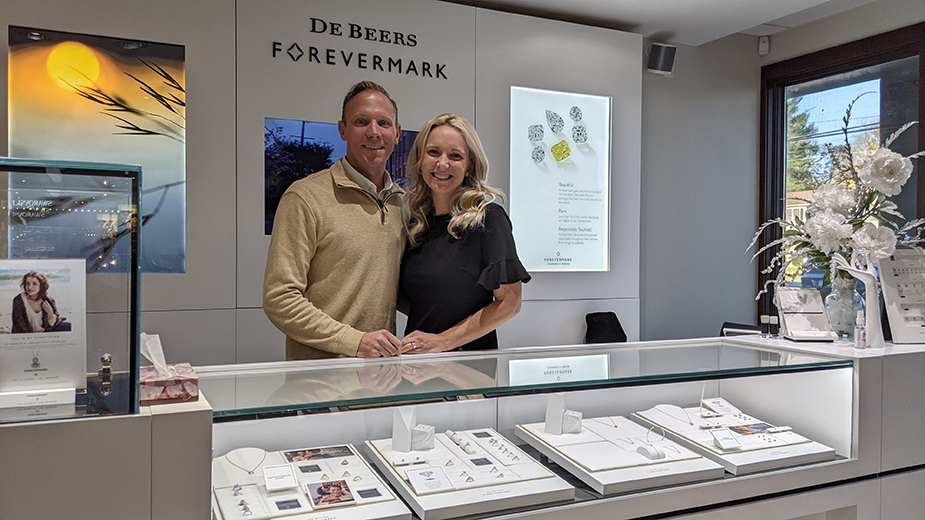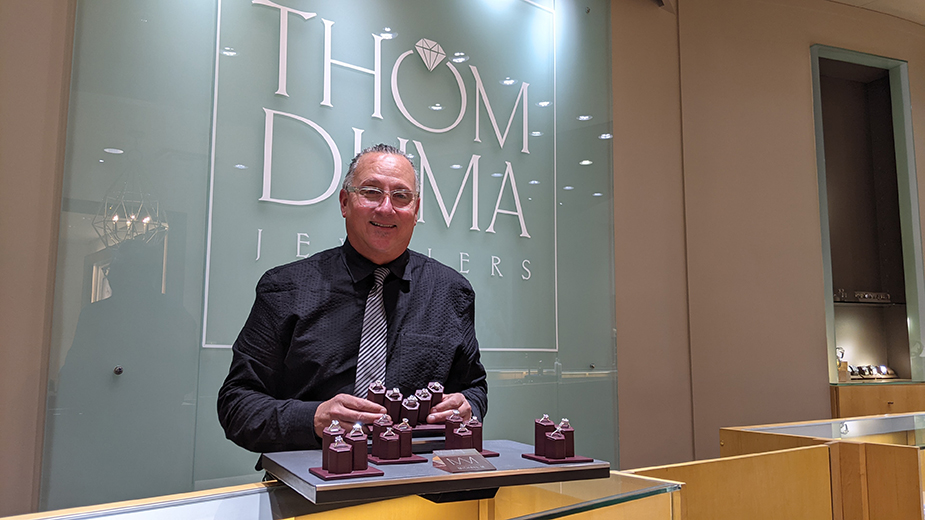YOUNGSTOWN, Ohio – Couples cooped up together during the pandemic likely ended up deeper in love – or on each other’s nerves.
Either way, nothing says “I love you” (or “I’m sorry”) like a diamond.
Diamond sales are up well over 2020, jewelers in the area say – above even pre-pandemic levels, driven largely by increased demand, the holiday shopping season and changing trends in spending.
At Thom Duma Fine Jewelers, Warren, bridal sales account for nearly half of its business, says owner Tom Duma. The shop took a hit in 2020 when the pandemic closed things down from mid-March until May. April is its biggest month for bridal sales. Since reopening, however, bridal has been setting records.
In the first 10 months of 2021, bridal revenue increased 64% year-over-year for Duma, with units sold up 32%.
“We never really made back the revenue that I lost for the eight weeks that we were shut down. But when you look at it year-over-year, we were just having increases every single month,” he says.
“Everyone is loving diamonds,” agrees Brianna Komara Pridon, who manages Komara Jewelers, Cornersburg, with her brother, Rob.
In the last year, the shop has seen an uptick in diamond sales and other jewelry for special moments, she says. Year-over-year, sales are up 30%.
“I think through the pandemic, your love either got stronger or weakened,” Rob Komara says. “So there’s a lot of younger couples that are getting married a little bit quicker than you would see normally. Because they realize life is precious.”
Even when sales of lower-priced gift items were down, Cirelli Jewelers in Boardman saw an uptrend in higher-priced goods, says managing partner Jay Cichanski.
Last year, sales of diamond engagement rings beat 2019, he says, and sales year-to-date are up 35% over the same period in 2020.
Like the other jewelers, Cichanski says the pandemic “opened a lot of people’s eyes” who were sitting on the fence with marriage.
“For people who might have been hesitant to pull the trigger, last year got them to say, ‘What are we waiting for,’ ” he says.
In January through May 2021, overall U.S. jewelry sales increased by 41% to $32 billion, up from $22.7 billion in the same period in 2019, Forbes reports.
And from March through May, sales of diamond jewelry nationwide increased 30% over the same period in 2019.
Bigger Stones and Low Supply Drive Prices
The average centerstone sold at Thom Duma is about one carat. That’s up from the quarter-carat average Duma’s father sold in the early 1980s, he says.
While he still sells the smaller diamonds, demand is up for larger stones.
What helped, Duma suspects, is that pandemic-related restrictions prevented customers from taking luxury trips and cruises so “they had some extra disposable income.”
It also allowed some customers to upgrade from one carat to a two- or three-carat stone for anniversaries.
“We’re seeing a lot of people celebrating lasting love,” he says.
On average, a one-carat piece runs $6,000 to $8,000, Duma says, up from the $2,995 it would cost back in 2010.
The average age of couples getting engaged is also rising, Duma says. He’s met many 30- to 35-year-olds coming in for their first wedding purchase – people who have been working for about 10 years, compared to the younger buyers who would be just out of school, he says.
“So now they have more money to spend,” he says.

At Komara, the standard one-carat diamond sales of a few years ago have grown to 1½ to two carats, Komara Pridon confirms.
The quality has also gotten better, Rob Komara notes. “They’re getting nicer color and they’re getting better clarity,” he says.
The local jewelers’ observations are confirmed in “Are We Heading Towards a Diamond Price Bubble?” a report published in June by independent research firm Edahn Golan Diamond Research & Data.
The report found in the first five months of 2021, the average size of a set diamond increased to 1.22 carats from 1.06.
While Duma hasn’t had issues building his diamond inventory, he reports prices are higher.
During a recent buying trip, the price of diamonds was up 7% to 10% year-over-year, he says. But that trend was happening before the pandemic, he adds.
Supply and demand issues are driving price increases, but they aren’t necessarily being passed on to the consumer, according to Duma.
“We’re swallowing that increase to keep things stable,” he says.
Manufacturers are “doing their best to keep that down,” says Cirelli’s Cichanski.
The prices also reflect other highercosts that people don’t realize. Costs have risen for catalogs, boxes, packaging and shipping, he says.
“There’s nothing you can do. All you can do is try to wait it out,” Cichanski says.
Want Custom? Order Early
Jewelers are seeing more demand for custom pieces, particularly among millennials who don’t want to have the same ring everyone else has, Duma says.
To meet that demand, manufacturers are retooling.
“If you take this ring that’s sitting in my case, but you say you want these two outside edges in rose gold – and instead of black diamonds you want white diamonds – absolutely,” he says. “We don’t ever say ‘No’ anymore.”
Custom pieces can run anywhere from $500 to $50,000 – even more, depending on the piece and the size of the stone, among other things, Cichanski says. Cirelli does many custom eternity diamond rings.
The process of customizing a piece, however, isn’t always going to increase the price, he says.
Replacing the stones in a pair of earrings, for example, is more affordable.
“I think a lot of people come in and they feel if they use the word ‘custom,’ right out of the gate they’re going to spend more money than they anticipated,” he says. “You can customize anything you want.”
As for the metal, white gold remains king while rose gold is gaining traction and yellow gold is making a surprising comeback, the jewelers say.
The consensus is younger generations prefer the rose and yellow golds so they’ll differ from their parents, who made white gold popular.
“I mean, 15 years ago people were coming in with these big yellow gold necklaces and were like ‘Scrap it and take the money,’” Komara Pridon says. “Now, that’s the first thing on my Christmas list.”
As for stones, round diamonds outsell all other shapes, while the square princess cut that ruled the early 2000s is trending down.
Ovals are among the most popular “fancy shapes,” Komara Pridon says.
But marquise diamonds – an elongated elliptical shape with pointed ends – are coming back in popularity after being dormant the last 15 years, she continues.
Because of higher demand, custom work that typically takes four weeks is now backed up to around seven, Komara Pridon says.
That stems from issues with international manufacturers shutting down, Rob Komara says. “So you have 100 diamond cutters down to 10.”
Cichanski is seeing the same thing, with Cirelli’s designers saying custom deliveries can take up to three months rather than three to six days.
“Those people who typically deliver goods in three days to a week said if you’re not ordered by Oct. 15, you won’t have it for the holidays,” he says.
For local jewelers, custom orders are what set them apart from the chain retailers, he says. Local jewelers don’t carry the same things year-round and do many one-off, unique pieces.
“And you’re going to get 75 years of service behind it,” Cichanski says of Cirelli Jewelers. “We’re going to give you knowledge behind it. So when you walk out of the store, you’re going to be educated and confident in what you just bought.”
Jewelers Order Big to Meet Demand
With greater demand for custom jewelry and other items, Cirelli beefed up its inventory to the “most we’ve ever had in months,” Cichanski says.
In early November, his inventory was up about 30% over a typical year.
“We still have a lot of stuff that’s going to be delivered throughout the next couple of weeks,” he says. “Come that last week of December when typically we were still able to deliver a custom special order, I don’t know how anybody in any situation is going to be able to fulfill those orders for that end-of-December rush.”
Duma increased his inventory of wedding bands this year by 35% for women’s bands and 45% for men’s. He increased his shop’s inventory of loose diamonds by 74%, while semi-mounted pieces – those without a center stone – increased by 20%.
Komara Jewelers – known for its holiday promotion where any items purchased between Dec. 1 and 17 will be free if it snows four inches or more on Christmas Day – has been stocking up on diamonds for nearly the entire year, Komara Pridon says.
Their father, Robert Komara, handles the purchasing, “and we have a ton,” she says. The shop increased its inventory of loose diamonds by about 40%.
Rising prices are one reason, she says. Diamond jewelry items sell for 25% more now than they would have in the summer.
“We heard the fears of what was going to happen for the quarter,” she says. “So we did invest a lot in the diamonds and we still bought them at a great price.”
Still, certain stones are harder to come by.
“It’s a lot more work. With different vendors, you’ve got to make several calls,” Rob Komara says. “And they’re not budging on the price. Usually you can say, ‘Hey, can you take a little off here?’ And they’re like ‘No.’ Because they know that the next person will pay top dollar.”
Pictured at top: Monthly diamond sale increases are setting records at Thom Duma Fine Jewelers, Tom Duma says.
